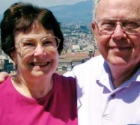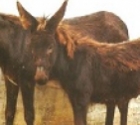
It was a fabulous day for a hike: early January, sun shining, cool temperature and a perfectly clear sky. Our Esra group made its first stop at a cafe/service station overlooking the Dead Sea, the lowest place on Earth. Our excellent guide, Avishai, began to tell us the sad story of the Dead Sea. Why sad? Because the Dead Sea (called the Salt Sea in Israel) is receding. The Dead Sea is located in the Syria-Africa Rift Valley, the longest fault line in the world, between Israel and Jordan. Avishai explained that the cataclysmic separation of the Sinai tectonic plate from the Arabian plate resulted in almost identical features on both sides of the valley, although separated by about 60 miles north to south. To illustrate this, he mentioned that the copper ore in Israel’s Timna valley is replicated by similar deposits to the north and east in Jordan.
The Dead Sea is shared equally by Israel and Jordan and both are responsible for its yearly depletion. The main reason for the large lake’s shrinkage – in addition to meager rainfall – is that since 1960 the Jordan River flow has been diverted, to a large extent, to provide water for drinking after it reaches the Sea of Galilee (Lake Kinneret), leaving only a relative trickle to reach its ultimate destination in the Dead Sea. Also significant in reducing the Jordan’s flow is Israel’s construction of the Degania dam on the Jordan River, as well as Syria’s dam on the Yarmuk river and Jordan’s Abdullah canal. The role that industry plays in the depletion of the sea is relatively small by comparison.
The Dead Sea’s southern basin, where we vacation at the Ein Boqek oasis, consists of man-made evaporation pools maintained by the Dead Sea Works. The “original” Dead Sea, the northern basin, is the part that is shrinking about one yard per year, while the southern pools are actually growing after the manufacturing company removes the valuable minerals, leaving shallow pools filled with less valuable salt. The two portions of the sea are now separated by land.
The need to slow the erosion of the sea has become more obvious in recent years, due to huge sinkholes along the shoreline. Besides threatening the tourist industry and agriculture in the area, the sink holes are safety hazards which have caused road accidents and the abandonment of some land adjacent to the water. Currently, a Red Sea-Dead Sea canal feasibility study is being conducted to examine the effects of the project on the ecological balance in the area, as well as the impact on the quality of the water itself.
Our hike began with a steep 1.5 mile ascent from Maale Rehaf (Rehaf heights). Twice, we diverted from the main path to see waterfalls and pools. The landscape was beautiful from the beginning to the end of our trek. While we were resting at the Rehaf pool, Avishai discussed the subject of what constitutes a “desert”. While most of us associate deserts with Lawrence of Arabia, the Arabian desert is not the most typical kind – although it’s the world’s largest “hot” desert. Each type of desert has different attributes, the main differentiation being between hot and cold deserts. Compare the immense sand dunes of the Arabian desert to the world’s largest desert, Antarctica, which is all ice.
The Judean desert, in which we were hiking, has large barren expanses of gravel plains and rocky outcrops. But all deserts have one thing in common: there is more evaporation than rainfall. A few years ago, quite close to where we sat, four experienced hikers drowned after a flash flood surprised them. Even more shocking was the fact that two of them were suspended on ropes (rappelling) at the time. The hard-packed, impenetrable ground of the small canyon in which they were hiking allowed the flood water to rise many yards, almost instantly, trapping them. We were suitably warned.
At the next pond that we visited (both ponds were dry or nearly so, as is the usual case in the desert except after a hard rain), a wide range of fauna inhabits the Judean desert, from wild asses to leopards. Camping next to a water source is prohibited because it would inhibit animals from coming to drink at night. In some areas it’s forbidden to remain near the water even in the late afternoon, as we learned last year, when a ranger requested us to move on after our late lunch break by a water hole.
Returning to the main trail, we enjoyed a two mile, almost flat walk along the desert plain, with stunning vistas at every turn. Our final ascent was to Mt. Elazar where we were treated to another stunning view of Masada from an unusual angle. We approached Masada from the southwest, and its grandeur was awesome. We could see remnants of the Roman forts that had surrounded it, the rampart Jewish slaves were forced to build to the summit and some of the ruins on Masada’s summit.
But the story Avishai chose to tell us was of the Zealots who defied the Roman 10th Legion after the fall of Jerusalem in 70 CE. The Zealots had been fighting the Romans for three generations. Their leader was Elazar ben Yair. The story comes to us from the writing of Flavius Josephus, the turncoat Jewish general who became the Roman emperor’s historian. Josephus describes how, when the Romans had nearly completed the rampart to the top of Masada in the spring of 73 CE, Elazar convinced the 960 warriors and their families to commit mass suicide. They did this rather than be slain or put into slavery by the Romans. Not only did the Romans find the corpses of the Jews when they finally reached Masada’s summit, they found plentiful foodstuffs that Elazar had ordered not to be destroyed, the better to show the Romans that the Jews had willingly died, rather than submit.
The history – or the myth – of Masada is writ large in our Israeli consciousness. Most glorify the extremist ethos of the Zealots’ suicide, while others criticize it. We had all been to the top of Masada as tourists or at ceremonies for the induction of our children into the Israel Defense Forces, which are often carried out at monumental sites like Masada. School children learn Elazar’s speech to the Zealots, as reported by Josephus: “…We were the very first that revolted [against Rome], and we are the last that fight against them; and I cannot but esteem it as a favor that God has granted us, that it is still in our power to die bravely, and in a state of freedom ...". These are words that resonate among most Israelis today, still fighting for our independence while surrounded by many who will never accept a Jewish state.
The long descent from Mt. Elazar would have been anticlimactic after Avishai’s rendition of the Masada story, except that it was the most grueling part of our hike. We slowly made our way down from the 1,200 ft. high summit to the parking lot of the beautiful youth hostel at Masada’s base. All the way down from the heights we enjoyed Jordan’s colorful Adomite mountains on the other side of the rift valley, with their changing reddish hues amplified by the setting sun. Often there's a mist in the area which obscures the view, but this time we enjoyed a panorama so clear that everything stood out in precise detail. It was a great ending to a fantastic outing.
 ESRA ASHKELON DONATED GOODS
ESRA ASHKELON DONATED GOODS  DEFIANCE TEL AVIV STYLE
DEFIANCE TEL AVIV STYLE  THE SPIRIT OF ESRA-JULES AND PERLA FOX- EXCEPTIONAL BENEFACTORS
THE SPIRIT OF ESRA-JULES AND PERLA FOX- EXCEPTIONAL BENEFACTORS A new website in English - on Volunteering - Launched in Israel
A new website in English - on Volunteering - Launched in Israel Help Needed for Abused Horses and Donkeys
Help Needed for Abused Horses and Donkeys Heather's Heseg
Heather's Heseg Steve Kramer
Steve Kramer